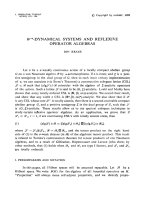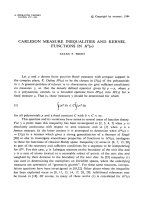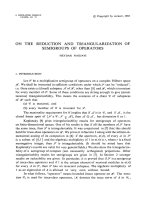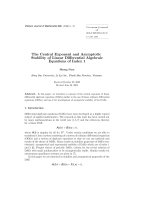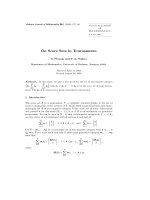Báo cáo toán học: " Disconnected vertex sets and equidistant code pairs" pdf
Bạn đang xem bản rút gọn của tài liệu. Xem và tải ngay bản đầy đủ của tài liệu tại đây (316.64 KB, 10 trang )
Disconnected vertex sets
and equidistant code pairs
Willem H. Haemers
Department of Econometrics, Tilburg University,
Tilburg, The Netherlands; e-mail:
Submitted: October 28, 1996; Accepted: January 29, 1997.
Abstract
Two disjoint subsets
A
and
B
of a vertex set
V
of a finite graph
G
are called
disconnected
if there is no edge between
A
and
B
.If
V
is the set of words of length
n
over an alphabet
{
1
, ,q}
and if two
words are adjacent whenever their Hamming distance is not equal to
afixed
δ∈{
1
, ,n}
, then a pair of disconnected sets becomes an
equidistant code pair
.
For disconnected sets
A
and
B
we will give a bound for
|A|·|B|
in terms of the eigenvalues of a matrix associated with
G
. In case
the complement of
G
is given by a relation of an association scheme
the bound takes an easy form, which applied to the Hamming scheme
leads to a bound for equidistant code pairs. The bound turns out to
be sharp for some values of
q
,
n
and
δ
,andfor
q→∞
for any fixed
n
and
δ
. In addition, our bound reproves some old results of Ahlswede
and others, such as the maximal value of
|A|·|B|
for equidistant code
pairs
A
ans
B
in the binary Hamming Scheme.
1 Introduction
Throughout G is a finite graph with vertex set V . Two disjoint subsets A
and B of V are disconnected ifthereisnoedgebetweenAand B. We define
Φ(G)tobethemaximumof
|
A
|·|
B
|
for disconnected sets A and B in G.
Suppose V is the set of words of length n over an alphabet
{
1, ,q
}
and
define two words adjacent if their Hamming distance (i.e. the number of
coordinates in which they differ) is not equal to a fixed δ
∈{
1, ,n
}
.Then
a pair of disconnected sets becomes an equidistant code pair.
the electronic journal of combinatorics 4 (1997), #R7 2
The quantity Φ(G) has an application in information theory and leads
to a lower bound for the two-way communication complexity of functions
defined on V
×
V that are constant over the non-edges of G. About ten years
ago this application caused some activity in the study of equidistant code
pairs. The best result is due to Ahlswede [1], who gives the exact value of
Φ(G)forq=2,4and5,foreveryδand n.
In this paper we will give a bound for Φ(G) in terms of eigenvalues of
a matrices associated with G. In case the complement of G is given by
a relation of an association scheme the bound takes an easy form, which
applied to the Hamming scheme leads to a bound for equidistant code pairs.
This bound is not as accurate as Ahlswede’s result, but it is more general
and it turns out to be sharp for some values of q, n and δ,andforq
→∞
for any fixed n and δ.
2 Disconnected vertex sets
Let V =
{
1, ,v
}
. We define
M
(G) to be the collection of symmetric v
×
v
matrices M with all row and column sums equal to 1, such that (M)
i,j
=0if
iand j are distinct non-adjacent vertices of G.Letλ
1
(M), ,λ
v
(M)denote
the eigenvalues of a matrix M
∈M
(G), such that λ
1
(M) has eigenvector 1
(the all-one vector), so λ
1
(M)=1. Put
λ(M)=max
i=1
|
λ
i
(M )
|
.
Lemma 2.1 If A and B are disconnected vertex sets of G and M
∈M
(G),
then
|
A
|·|
B
|
(v
−|
A
|
)(v
−|
B
|
)
≤
λ
2
(M).
Proof. See [7] Theorem 2.1, or [11] Lemma 6.1. 2
Theorem 2.2 For any M
∈M
(G)
Φ(G)
≤
v
λ(M)
1+λ(M)
.
theelectronicjournalofcombinatorics4(1997),#R7 3
Proof.PutΦ=Φ(G)andtakeAandBsuchthatΦ
2
=
|
A
|·|
B
|
.Thenby
Lemma2.1
Φ
2
λ
2
(M)
≤
(v
2
−
v(
|
A
|
+
|
B
|
)+Φ
2
)
≤
(v
2
−
2v
|
A
|·|
B
|
+Φ
2
)=(v
−
Φ)
2
.
Clearlyv
≥
Φ,soΦ
≤
(v
−
Φ)λ(M),whichyieldstherequiredbound.
InordertoinvestigatewhentheboundofTheorem2.2isbestpossible,we
define
φ(G)=min
M∈M(G)
v
λ(M)
1+λ(M)
andwelet
M
(G)denotethesetofmatricesfrom
M
(G)forwhichthe
aboveminimumisattained.ThusTheorem2.2becomesΦ(G)
≤
φ(G).To
determineφ(G)weneedtofindamatrixin
M
(G).Forthatpurposethe
automorphismsofGcanbehelpful.
Lemma2.3Let
A
beanautomorphismgroupofG.Then
M
(G)contains
amatrixwhichisconstantovereachorbitoftheactionof
A
onV
×
V.
Proof.LetP
g
denotethepermutationmatrixcorrespondingtog
∈A
and
takeM
∈M
(G).ThenclearlyP
g
M
P
g
∈M
(G)and,byRayleigh’s
principle,
|
u
P
g
M
P
g
u
|≤
λ(M
)foreveryunitvectoruorthogonalto1 .
Define
M=
1
|A|
g∈A
P
g
M
P
g
,
thenclearly M
∈M
(G)andMisconstantover
A
-orbitsonV
×
V.Let
u(u
⊥
1)beauniteigenvectorfortheeigenvalue
±
λ(M).Thenλ(M)=
|
u
Mu
|≤
λ(M
),soλ(M)=λ(M
)andhence M
∈M
(G). 2
InparticularwemaytakethediagonalconstantifGhasatransitiveauto-
morphismgroup.Theorem2.2leadstoamoreexplicitboundintermsofthe
LaplacianeigenvaluesofG.(IfAisthestandardadjacencymatrixofGand
Disthediagonalmatrixcontainingthevertexdegrees,thenF=D
−
Ais
theLaplacianmatrixofG.IteasilyfollowsthatFispositivesemi-definite
andsingular;seeforexampleBrualdiandRyser[6].)
theelectronicjournalofcombinatorics4(1997),#R7 4
Theorem2.4SupposeFistheLaplacianmatrixofGandlet0=µ
1
≤
µ
2
≤
≤
µ
v
betheeigenvaluesofF,then
φ(G)
≤
v
2
1
−
µ
2
µ
v
withequalityifGhasanautomorphismgroupthatactstransitivelyonthe
edges.
Proof.Define
M=
−
2
µ
2
+µ
v
F+I.
ThenM
∈M
(G)andλ(M)=(µ
v
−
µ
2
)/(µ
v
+µ
2
),whichyieldstheinequal-
ity.
SupposeGhasanautomorphismgroupwhichactstransitivelyonthe
edges.Then,byLemma2.3thereexistsamatrixM
∈M
(G)suchthat
M
=xF+DforsomeconstantxanddiagonalmatrixD.NowM
1=1
givesD=Iandso
λ(M
)=max
{|
xµ
2
+1
|
,
|
xµ
v
+1
|}
.
Itfollowsthatλ(M
)isminimalifxµ
2
+1=
−
xµ
v
−
1,thatis,ifx=
−
2/(µ
2
+µ
v
).ThusM
∈M
(G).
Example.SupposeGisthetriangulargraphT(2m)(thatis,thelinegraph
ofK
2m
).Thenv=m(2m
−
1),µ
2
=2mandµ
v
=4m
−
2.Theorem2.4
givesφ(G)=
m
2
.WeeasilyhavethatΦ(G)
≥
m
2
,soΦ(G)=
m
2
.
Nextweconsiderassociationschemes.Fortheoryandnotationsee[4],[5]
or[9].LetSbeann-classassociationschemedefinedonthesetVwith
relationsR
0
, ,R
n
.Forδ
∈{
1, ,n
}
wedenotebyG
δ
thegraph(V,R
δ
)
andbyG
δ
thecomplementofG
δ
.
Theorem2.5IfQisthematrixofdualeigenvaluesofS,then
φ(G
δ
)
≤
v
n
j=0
|
Q
δ,j
|
.
the electronic journal of combinatorics 4 (1997), #R7 5
Equality holds if the automorphism group of S acts transitively on each rela-
tion.
Proof. Let A
0
, ,A
n
(with A
0
= I) be the adjacency matices of S and let
E
0
, ,E
n
(with vE
0
= J, the all-one matrix) be the minimal idempotents.
Then the matrix Q of dual eigenvalues is given by
vE
j
=
n
i=0
Q
i,j
A
i
, for j =0, ,n.
So v(E
j
)
k,l
= Q
δ,j
whenever
{
k, l
}∈
R
δ
. Define
P
δ
=
{
j
|
1
≤
j
≤
n, Q
δ,j
>
0
}
, m =
j∈P
δ
Q
δ,j
+
1
2
and
M =
1
m
(
1
2
I
−
j∈P
δ
(E
j
−
Q
δ,j
E
0
)).
Then, since E
j
1 =0for j
= 0 one readily verifies that M
∈M
(G
δ
).
Moreover
j∈P
δ
E
j
has only 0 and 1 as eigenvalues. This implies that
λ
i
(M)=
±
1
2m
for i
=1,soλ(M)=
1
2m
, and thus we find φ(G
δ
)
≤
v
2m+1
.By
use of
n
j=0
Q
δ,j
=0andQ
δ,0
=1,weobtain
m+
1
2
=1+
j∈P
δ
Q
δ,j
=
1
2
n
j=0
|
Q
δ,j
|
,
and the required inequality follows.
Next assume that S admits an automorphism group which is transitive on
each relation. Then by Lemma 2.3 there exists a matrix M
∈M
(G
δ
)which
is a linear combination of A
0
, ,A
n
,thatis,M
is in the Bose-Messner
algebra of S.Letλ
j
(M
) denote the eigenvalue of M
whose eigenspace
is given by E
j
. We claim that we may assume that λ
j
(M
)=λ(M
)if
Q
δ,j
≤
0. Indeed, suppose this is not the case, then define d = λ(M
)
−
λ
j
(M
), m =1
−
dQ
δ,j
and M
=
1
m
(M
+ d(E
j
−
Q
δ,j
E
0
)). It follows that
M
∈M
(G
δ
), m
≥
1andλ
j
(M
)=λ(M
)=
1
m
λ(M
)
≤
λ(M
). So we can
redefine M
= M
, which proves the claim. Similarly, we may assume that
λ
j
(M
)=
−
λ(M
)ifQ
δ,j
≥
0andj
= 0. It now follows that
E =
1
2λ(M
)
(λ(M
)I
−
M
+(λ(M
)
−
1)E
0
)
theelectronicjournalofcombinatorics4(1997),#R7 6
haseigenvalue0and1only,andhenceEisanidempotentofS.Therefore
EisthesumofthoseE
j
thatcorrespondtotheeigenvalue1ofE,that
isE=
j∈P
δ
E
j
.Inaddition,since(M
)
k,l
=0for
{
k,l
}∈
R
δ
,wehave
j∈P
δ
Q
δ,j
=
1
2λ(M
)
−
1
2
.ThisimpliesthatM
=M,soM
∈M
(G
δ
).
AgraphG
δ
ina2-classassociationschemeisthesameasastronglyregular
graph.AnexampleofsuchagraphisthetriangulargraphT(m),described
intheexampleabove.Itisnotdifficulttoseethatforstronglyregulargraphs
theboundsofTheorem2.4andTheorem2.5coincide.
3 Equidistantcodepairs
SupposeV=
{
1, ,q
}
n
,thesetofwordsoflengthnoveranalphabetofsize
q,anddefinetwowordstobeinrelationR
δ
iftheirHammingdistance(the
numberofcoordinateplacesinwhichtheydiffer)equalsδ.Thisdefinesthe
wellknownHammingassociationschemeH(n,q).ForagraphG
δ
inH(n,q)
twodisconnectedsetsinG
δ
arecalledequidistantcodepairs(atdistanceδ)
andwewriteΦ
δ
andφ
δ
insteadofΦ(G
δ
)andφ(G
δ
)respectively.
Lemma3.1
Φ
2
δ
≥
max
0≤δ
≤δ
n
−
δ
δ
−
δ
(q
−
1)
δ−δ
q
2
q
2
δ
.
Proof.TakeforAthesetofwords(x
1
, ,x
n
)with1
≤
x
i
≤
q
2
ifi
≤
δ
and
x
i
=1ifi>δ
,andletBconsistofthewords(x
1
, ,x
n
)with
q
2
<x
i
≤
qif
i
≤
δ
andx
i
=1forpreciselyδ
−
δ
valuesofi>δ
.ThenAandBforman
equidistantcodepairatdistanceδwithsizes
q
2
δ
and
q
2
δ
n−δ
δ−δ
(q
−
1)
δ−δ
,
respectively. 2
TheaboveconstructionwasgivenbyAhlswede[1].Heprovesthatequality
holdsforq=4andq=5andconjecturesequalityforallq
≥
4.Forq=2
andq=3thereexistbetterconstructionsofequidistantcodepairs(see
below).
theelectronicjournalofcombinatorics4(1997),#R7 7
TheHammingschemeisself-dual,whichmeansthatthedualeigenvalues
coincidewiththeeigenvalues.Theyaregivenby(see[8]):
Q
δ,j
=
n
k=0
(
−
1)
k
(q
−
1)
j−k
δ
k
n
−
δ
j
−
k
forδ,j
∈{
0, ,n
}
.
TheautomorphismgroupofH(n,q)istransitiveoneachrelation,soTheo-
rem2.5givestheexactvalueofφ
δ
foralln,qandδ.
ExampleIfn=6andq=6,thenforj=0, ,6therespectivevaluesof
Q
4,j
are1,6,
−
9,
−
44,111,
−
90and25.Theorem2.5givesφ
4
=46656/286
≈
163.13.WithLemma3.1(takeδ
=2)wefind45
√
6
≤
Φ
4
≤
23328/143.
ThisexampleshowsthatourboundwillnotproveAhlswede’sconjecture.
Butitcangiveinterestingresultsinsomecases.
Theorem3.2Ifq>2then
φ
δ
≤
q
n
(q
−
2)
n−δ
2
δ
.
Equalityholdsifandonlyifδ=n.
Proof.TheinequalityfollowsfromTheorem2.5and
n
j=0
|
Q
δ,j
|≥|
n
j=0
(
−
1)
j
Q
δ,j
|
=
n
k=0
δ
k
n
j=0
(
−
1)
j−k
(q
−
1)
j−k
n
−
δ
j
−
k
=2
δ
(q
−
2)
n−δ
.
Ifjrunsfrom0ton,Q
n,j
alternatesinsign,sowehaveequalityifδ=n.
Thedualeigenvaluesofanyassociationschemesatisfy
n
j=0
1
µ
j
Q
δ,j
Q
n,j
=0
ifδ
=n(µ
j
=rkE
j
).ThereforeQ
δ,j
cannotalternateinsignifδ
=n,so
thenwehavestrictinequality.
Corollary3.3Ifq>2then
Φ
δ
≤
q
n
(q
−
2)
n−δ
2
δ
.
Equalityholdsifandonlyifδ=nandqiseven.
theelectronicjournalofcombinatorics4(1997),#R7 8
Proof.Ifδ=nandqiseven,Lemma3.1(withδ
=δ)givesΦ
n
≥
(
q
2
)
n
,
whichequalsφ
n
.Ifqisodd,(
q
2
)
2n
isnotaninteger,soΦ
n
=φ
n
.
WeseethatthelowerboundofLemma3.1andtheupperboundofCorol-
lary3.3tendtothesamevalue(
q
2
)
δ
ifq
→∞
.Moreprecisely:
Corollary3.4
Φ
δ
=
q
2
δ
+O(q
δ−1
)(q
→∞
).
Forq
≥
4AhlswedeandM¨ors[3]showedthatΦ
δ
<Φ
n
ifδ<n.Thisresult
nowfollowsdirectlyfromCorollary3.3whenqisevenand,byLemma3.1,
alsowhenqisoddandnisnottoobig.
Forq=3notmuchisknownaboutΦ
δ
.Ahlswede[1]hasaconstruction
forequidistantcodepairsandconjecturesthatitisbestpossible.Ifthisis
truethenΦ
δ
attainsitsmaximalvalue
3
2
n
3
2
n
2
ifδ=
2n
3
.Theorem3.2givesφ
n
=(
3
2
)
n
,thuswehavethatΦ
n
<Φ
δ
if
δ=
2n
3
(n>2).ByuseofTheorem2.5,strongerresultsarepossible,butit
turnsoutthattheboundφ
δ
isnotgoodenoughtoprovethatΦ
δ
ismaximal
ifδ=
2n
3
.
Forq=2thevalueΦ
δ
isknownforallδ;see[1].Itattainsthemaxi-
malvalue2
n
2
ifδ=
n
2
andifδ=
n
2
.Thisresultwasfirstprovedby
Ahlswede,ElGamalandPang[2]andhasseveraldifferentproofsnow(see
[1]).Weshallseethatourboundprovidesyetanotherproof.Theconstruc-
tionisasfollows.TakeforAthesetofwords(x
1
, ,x
n
)withx
2i−1
=x
2i
for1
≤
i
≤
n
2
andx
n
=1ifnisodd.TakeforBthesetofwordswith
x
2i−1
=x
2i
for1
≤
i
≤
n
2
andx
n
fixedifnisodd.ThenAandBare
equidistantcodepairsatdistance
n
2
or
n
2
and
|
A
|
=
|
B
|
=2
n
2
.
Theorem3.5Ifq=2then
φ
δ
≤
2
n
2
forδ
∈{
1, ,n
}
.
Equalityholdsifδ
∈{
n
2
,
n
2
}
.
theelectronicjournalofcombinatorics4(1997),#R7 9
Proof.Withi=
√
−
1wehave
n
j=0
i
j
Q
δ,j
=
n
k=0
i
−k
δ
k
n
j=0
i
j−k
n
−
δ
j
−
k
=(1
−
i)
δ
(1+i)
n−δ
=
2
n
2
ω,
whereinω=e
πi
4
(n−2δ)
.Hence
n
j=0
|
Q
δ,j
|
=
jeven
|
Q
δ,j
|
+
jodd
|
Q
δ,j
|≥
2
n
2
(
|
Reω
|
+
|
Imω
|
)=
2
n
2
,
andtheinequalityfollowsbyuseofTheorem2.5.Theconstructionabove
showsthatΦ
δ
=φ
δ
=2
n
2
if
|
n
2
−
δ
|≤
1
2
.
WithasimilarargumentandabitmoreworkasintheproofofTheorem3.2
itcanbeseenthatif
|
n
2
−
δ
|≥
1theboundφ
δ
isstrictlylessthan2
n
2
.
4 Concludingremarks
Thereissomesimilaritybetweenourfunctionφ(G)andLov´asz’sfunction
θ(G)(see[12]).Thelatterfunctiongivesanupperboundforacoclique
(independentsetofvertices)inG,whichis,inasense,avertexsetdiscon-
nectedtoitself.Lovasz’sθ(G)isknowntobecomputableinpolynomialtime
(see[10]),butwedonotknowthecomplexityofthecomputationofφ(G)
andΦ(G).
IfweapplyTheorem2.5totheJohnsonassociationschemeJ(m,n),we
obtainboundsforequidistantcodepairsin(binary)constantweightcodes.
Itseemscertainlyworthwhiletoworkthisoutandweintendtodoso.The
problemisthattheformulasforthedualeigenvaluesarerathercomplicated.
Forthespecialcasethatδ=nwebelievedthat
j
|
Q
δ,j
|
=
m
2
n
,buthad
noproof,untilVolkerStrehl(privatecommunication)provideduswitha
computer-generatedproofbyuseofZeilberger’salgorithm.
Acknowledgement.Theresearchforthispaperwasdonewhentheau-
thorwasaguestoftheSonderforschungsbereich“DiskreteStructureninder
Mathematik”attheUniversityofBielefeld.SpecialthanksgoestoProfessor
RudiAhlswedefortheinvitation,andseveralfruitfuldiscussionsconcerning
thesubject.
the electronic journal of combinatorics 4 (1997), #R7 10
References
[1] R. Ahlswede, On code pairs with specified Hamming distances, Colloquia
Mathematica Societas J´anos Bolyai 52, Combinatorics, Eger (Hungary),
1987, pp. 9-47.
[2] R. Ahlswede, A. El Gamal and K.F. Pang, A two-family extremal prob-
lem in Hamming space, Discrete Math. 49 (1984), 1-5.
[3] R. Ahlswede and M. M¨ors, Inequalities for code pairs, Europ. J. Com-
binatorics 9 (1988), 175-181.
[4] A.E.Brouwer,A.M.CohenandA.Neumaier,Distance-regular graphs,
Springer-Verlag, Berlin, 1989.
[5] A.E. Brouwer and W.H. Haemers, Association schemes, chapter 15 in:
Handbook of Combinatorics (R. Graham, M. Gr¨otschel and L. Lov´asz
eds.), Elsevier Science, Amsterdam, 1995, pp. 747-771.
[6] R.A. Brualdi and H.J. Ryser, Combinatorial matrix theory, Cambridge
University Press, Cambridge, 1991.
[7] E.R. van Dam and W.H. Haemers, Eigenvalues and the diameter of
graphs, Linear Multilinear Algebra 39 (1995), 33-44.
[8] Ph. Delsarte, An algebraic approach to the association schemes of coding
theory, Philips Research Rep. Suppl. 10, 1973.
[9] C.D. Godsil, Algebraic combinatorics, Chapman and Hall, New York -
London, 1993.
[10] M. Gr¨otschel, L. Lov´asz and A. Schrijver, The ellipsoid method and its
consequences in combinatorial optimization, Combinatorica 1 (1981),
169-197.
[11] W.H. Haemers, Interlacing eigenvalues and graphs, Linear Algebra
Appl. 226-228 (1995), 593-616.
[12] L. Lov´asz, On the Shannon capacity of a graph, IEEE Trans. Inform.
Theory 25 (1979), 1-7.


